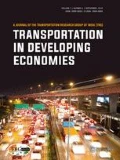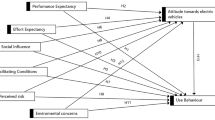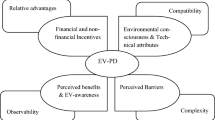Abstract
Advancements in energy-efficient sustainable mobility technologies like electric vehicles are considered as one of the essential responses to minimizing the greenhouse gas emissions from the transportation sector. In spite of financial and non-financial incentives being provided to both consumers and manufacturers in India, the acceptance and adoption of electric vehicles remains very low. Based on the extended unified theory of acceptance and use of technology (UTAUT) model, this study uses structural equation modelling to analyze the effects of eight factors viz. environmental enthusiasm, technological enthusiasm, anxiety (or perceived risk), social image, social influence, perceived benefits, performance expectancy and facilitating conditions on the consumers’ intention to adopt electric vehicles. The study is analytically examined based on the data obtained from 675 students in Bengaluru, India. Results indicate that environmental enthusiasm, technological enthusiasm, social image, social influence, perceived benefits, and performance expectancy are positively related to adoption intention whereas facilitating conditions and anxiety have negative influence on a consumer’s intention to adopt an electric vehicle. This study adds to the limited literature on this subject in the context of developing economies. In practice, the results from this study can be useful to planners and policy makers to improve the adoption rate of electric vehicles.


Similar content being viewed by others
References
Kahn Ribeiro S, Kobayashi S, Hata H et al (2007) Transport and its infrastructure. In: Climate change 2007: Mitigation. Cambridge University Press, Cambridge
U.S. EIA (2017) International Energy Outlook 2016
IEA (2009) World Energy Outlook 2009. IEA, Paris
IEA (2020) Tracking Transport 2020. IEA, Paris
Lefevre B, Enriquez A (2014) Transport Sector Key to Closing the World’s Emissions Gap|World Resources Institute. https://www.wri.org/insights/transport-sector-key-closing-worlds-emissions-gap. Accessed 6 May 2021
MoRTH (2020) Ministry of road transport and highways annual report 2020–2021
Wu T, Zhao H, Ou X (2014) Vehicle ownership analysis based on GDP per capita in China: 1963–2050. Sustainability (Switzerland) 6:4877–4899. https://doi.org/10.3390/su6084877
Lu H, Ma H, Sun Z, Wang J (2017) Analysis and prediction on vehicle ownership based on an improved stochastic gompertz diffusion process. J Adv Transp. https://doi.org/10.1155/2017/4013875
IEA (2020) World energy balances: overview. IEA, Paris
IQ Air (2019) World Air Quality Report 2019
Eckstein D, Kunzel V, Schafer L (2021) Global Climate Risk Index 2021
UN environment (2018) Emissions Gap Report 2018. Kenya
Bakker S, Jacob Trip J (2013) Policy options to support the adoption of electric vehicles in the urban environment. Transp Res Part D Transp Environ 25:18–23. https://doi.org/10.1016/j.trd.2013.07.005
Sierzchula W (2014) Factors influencing fleet manager adoption of electric vehicles. Transp Res Part D Transp Environ 31:126–134. https://doi.org/10.1016/j.trd.2014.05.022
Romm J (2006) The car and fuel of the future. Energy Policy 34:2609–2614. https://doi.org/10.1016/j.enpol.2005.06.025
Lieven T, Mühlmeier S, Henkel S, Waller JF (2011) Who will buy electric cars? An empirical study in Germany. Transp Res Part D: Transp Environ 16:236–243. https://doi.org/10.1016/j.trd.2010.12.001
Ajzen I, Fishbein M (1980) Understanding attitudes and predicting social behavior. Prentice-Hall, Englewood Cliffs
Egbue O, Long S (2012) Barriers to widespread adoption of electric vehicles: an analysis of consumer attitudes and perceptions. Energy Policy 48:717–729. https://doi.org/10.1016/j.enpol.2012.06.009
Skippon S, Garwood M (2011) Responses to battery electric vehicles: UK consumer attitudes and attributions of symbolic meaning following direct experience to reduce psychological distance. Transp Res Part D Transp Environ 16:525–531. https://doi.org/10.1016/j.trd.2011.05.005
Wang S, Fan J, Zhao D et al (2016) Predicting consumers’ intention to adopt hybrid electric vehicles: using an extended version of the theory of planned behavior model. Transportation 43:123–143. https://doi.org/10.1007/s11116-014-9567-9
Stern PC, Dietz T, Abel TD et al (1999) A value-belief-norm theory of support for social movements: the case of environmentalism. Hum Ecol Rev 6:81–97
Ajzen I (1991) The theory of planned behavior. Organ Behav Hum Decis Process 50:179–211. https://doi.org/10.1016/0749-5978(91)90020-T
Ozaki R, Sevastyanova K (2011) Going hybrid: an analysis of consumer purchase motivations. Elsevier 39:2217–2227
Carley S, Krause RM, Lane BW, Graham JD (2013) Intent to purchase a plug-in electric vehicle: a survey of early impressions in large US cites. Transp Res Part D Transp Environ 18:39–45. https://doi.org/10.1016/j.trd.2012.09.007
Krupa JS, Rizzo DM, Eppstein MJ et al (2014) Analysis of a consumer survey on plug-in hybrid electric vehicles. Transp Res Part A Policy Pract 64:14–31. https://doi.org/10.1016/j.tra.2014.02.019
Han L, Wang S, Zhao D, Li J (2017) The intention to adopt electric vehicles: driven by functional and non-functional values. Transp Res Part A Policy Pract 103:185–197. https://doi.org/10.1016/j.tra.2017.05.033
He X, Zhan W, Hu Y (2018) Consumer purchase intention of electric vehicles in China: the roles of perception and personality. J Clean Prod 204:1060–1069. https://doi.org/10.1016/j.jclepro.2018.08.260
Afroz R, Rahman A, Masud MM et al (2015) How individual values and attitude influence consumers’ purchase intention of electric vehicles—some insights from Kuala Lumpur, Malaysia. Environ Urban Asia 6:193–211. https://doi.org/10.1177/0975425315589160
Sheth JN, Newman BI, Gross BL (1991) Why we buy what we buy: a theory of consumption values. J Bus Res 22:159–170. https://doi.org/10.1016/0148-2963(91)90050-8
Holbrook MB, Hirschman EC (1982) The experiential aspects of consumption: consumer fantasies, feelings, and fun. J Consum Res 9:132. https://doi.org/10.1086/208906
Levy M (1999) Revolutionizing the retail pricing game discount store news | course hero. Discount Store News 38(September):15
Holbrook MB (1996) Special session summary customer value C a framework for analysis and research. ACR North American Advances NA-23
Zeithaml VA (1988) Consumer perceptions of price, quality, and value: a means-end model and synthesis of evidence. J Mark 52:2–22. https://doi.org/10.1177/002224298805200302
Gwinner KP, Gremler DD, Bitner MJ (1998) Relational benefits in services industries: the customer’s perspective. J Acad Mark Sci 26:101–114. https://doi.org/10.1177/0092070398262002
Roy A (1994) Correlates of mall visit frequency. J Retail 70:139–161. https://doi.org/10.1016/0022-4359(94)90012-4
Babin BJ, Darden RD, Griffin M (1994) Work and/or fun: measuring hedonic and utilitarian shopping value. J Consum Res 20:644–656
Sheth JN (1983) An integrative theory of patronage preference and behavior. In: Darden WR, Lusch RF (eds) Patronage behavior and retail management. Elsevier Science Publishing Company, New York
Forsythe S, Liu C, Shannon D, Gardner LC (2006) Development of a scale to measure the perceived benefits and risks of online shopping. J Interact Mark 20:55–75. https://doi.org/10.1002/dir.20061
Rezvani Z, Jansson J, Bodin J (2015) Advances in consumer electric vehicle adoption research: a review and research agenda. Transp Res Part D Transp Environ 34:122–136. https://doi.org/10.1016/j.trd.2014.10.010
Heffner RR, Kurani KS, Turrentine TS (2007) Symbolism and the adoption of fuel-cell vehicles. World Electr Veh J 1:24–31. https://doi.org/10.3390/wevj1010024
Heffner RR, Kurani KS, Turrentine TS (2007) Symbolism in California’s early market for hybrid electric vehicles. Transp Res Part D Transp Environ 12:396–413. https://doi.org/10.1016/j.trd.2007.04.003
Bunce L, Harris M, Burgess M (2014) Charge up then charge out? Drivers’ perceptions and experiences of electric vehicles in the UK. Transp Res Part A Policy Pract 59:278–287. https://doi.org/10.1016/j.tra.2013.12.001
Glerum A, Stankovikj L, Thémans M, Bierlaire M (2014) Forecasting the demand for electric vehicles: accounting for attitudes and perceptions. Transp Sci 48:483–499. https://doi.org/10.1287/trsc.2013.0487
She ZY, Sun Q, Ma JJ, Xie BC (2017) What are the barriers to widespread adoption of battery electric vehicles? A survey of public perception in Tianjin, China. Transp Policy 56:29–40. https://doi.org/10.1016/j.tranpol.2017.03.001
Bjerkan KY, Nørbech TE, Nordtømme ME (2016) Incentives for promoting Battery Electric Vehicle (BEV) adoption in Norway. Transp Res Part D Transp Environ 43:169–180. https://doi.org/10.1016/j.trd.2015.12.002
Sierzchula W, Bakker S, Maat K, van Wee B (2014) The influence of financial incentives and other socio-economic factors on electric vehicle adoption. Energy Policy 68:183–194. https://doi.org/10.1016/j.enpol.2014.01.043
Venkatesh V, Morris MG, Davis GB, Davis FD (2003) User acceptance of information technology: toward a unified view. MIS Q 27:425–478
Martins C, Oliveira T, Popovič A (2014) Understanding the internet banking adoption: a unified theory of acceptance and use of technology and perceived risk application. Int J Inf Manag 34:1–13. https://doi.org/10.1016/j.ijinfomgt.2013.06.002
Maillet É, Mathieu L, Sicotte C (2015) Modeling factors explaining the acceptance, actual use and satisfaction of nurses using an Electronic Patient Record in acute care settings: an extension of the UTAUT. Int J Med Inform 84:36–47. https://doi.org/10.1016/j.ijmedinf.2014.09.004
Kabra G, Ramesh A, Pervaiz A, Dash MK (2017) Understanding behavioural intention to use information technology: insights from humanitarian practitioners. Telemat Inform 34:1250–1261. https://doi.org/10.1016/j.tele.2017.05.010
Khalilzadeh J, Ozturk AB, Bilgihan A (2017) Security-related factors in extended UTAUT model for NFC based mobile payment in the restaurant industry. Comput Hum Behav 70:460–474. https://doi.org/10.1016/j.chb.2017.01.001
Yeung SPM (2004) Teaching approaches in geography and students’ environmental attitudes. Environmentalist 24:101–117. https://doi.org/10.1007/s10669-004-4801-1
Fujii S (2006) Environmental concern, attitude toward frugality, and ease of behavior as determinants of pro-environmental behavior intentions. J Environ Psychol 26:262–268. https://doi.org/10.1016/j.jenvp.2006.09.003
Pagiaslis A, Krontalis AK (2014) Green consumption behavior antecedents: environmental concern, knowledge, and beliefs. Psychol Mark 31:335–348. https://doi.org/10.1002/mar.20698
Sinnappan P, Rahman AA (2011) Antecedents of green purchasing behavior among Malaysian consumers. Int Bus Manag 5:129–139. https://doi.org/10.3923/ibm.2011.129.139
Rogers EM, Shoemaker FF (1971) Communication of innovations; a cross-cultural approach, 2nd edn. Free Press, New York
Turrentine TS, Kurani KS (2007) Car buyers and fuel economy? Energy Policy 35:1213–1223. https://doi.org/10.1016/j.enpol.2006.03.005
Liu Y, Li H, Carlsson C (2010) Factors driving the adoption of m-learning: an empirical study. Comput Educ 55:1211–1219. https://doi.org/10.1016/j.compedu.2010.05.018
Parveen F, Sulaiman A (2008) Technology complexity, personal innovativeness and intention to use wireless internet using mobile devices in Malaysia. Int Rev Bus Res Pap 4:1–20
Jansson J (2011) Consumer eco-innovation adoption: assessing attitudinal factors and perceived product characteristics. Bus Strateg Environ 20:192–210. https://doi.org/10.1002/bse.690
Kim C, Mirusmonov M, Lee I (2010) An empirical examination of factors influencing the intention to use mobile payment. Comput Hum Behav 26:310–322. https://doi.org/10.1016/j.chb.2009.10.013
Lewis W, Agarwal R, Sambamurthy V (2003) Sources of influence on beliefs about information technology use: an empirical study of knowledge workers. MIS Q Manag Inf Syst 27:657–678. https://doi.org/10.2307/30036552
Lu J, Liu C, Yu CS, Wang K (2008) Determinants of accepting wireless mobile data services in China. Inf Manag 45:52–64. https://doi.org/10.1016/j.im.2007.11.002
Meuter ML, Bitner MJ, Ostrom AL, Brown SW (2005) Choosing among alternative service delivery modes: an investigation of customer trial of self-service technologies. J Mark 69:61–83. https://doi.org/10.1509/jmkg.69.2.61.60759
Oliver J, Rosen D (2010) Applying the environmental propensity framework: a segmented approach to hybrid electric vehicle marketing strategies. J Market Theory Pract 18:377–393. https://doi.org/10.2753/MTP1069-6679180405
Sweeney JC, Soutar GN (2001) Consumer perceived value: the development of a multiple item scale. J Retail 77:203–220. https://doi.org/10.1016/S0022-4359(01)00041-0
Schuitema G, Anable J, Skippon S, Kinnear N (2013) The role of instrumental, hedonic and symbolic attributes in the intention to adopt electric vehicles. Transp Res Part A Policy Pract 48:39–49. https://doi.org/10.1016/j.tra.2012.10.004
Eppstein MJ, Grover DK, Marshall JS, Rizzo DM (2011) An agent-based model to study market penetration of plug-in hybrid electric vehicles. Energy Policy 39:3789–3802. https://doi.org/10.1016/j.enpol.2011.04.007
Chen CF, Xu X, Frey S (2016) Who wants solar water heaters and alternative fuel vehicles? Assessing social-psychological predictors of adoption intention and policy support in China. Energy Res Soc Sci 15:1–11. https://doi.org/10.1016/j.erss.2016.02.006
Jansson J, Marell A, Nordlund A (2010) Green consumer behavior: determinants of curtailment and eco-innovation adoption. J Consum Mark 27:358–370. https://doi.org/10.1108/07363761011052396
Zhang X, Wang K, Hao Y et al (2013) The impact of government policy on preference for NEVs: the evidence from China. Energy Policy 61:382–393. https://doi.org/10.1016/j.enpol.2013.06.114
Kang MJ, Park H (2011) Impact of experience on government policy toward acceptance of hydrogen fuel cell vehicles in Korea. Energy Policy 39:3465–3475. https://doi.org/10.1016/j.enpol.2011.03.045
Verma M, Verma A, Khan M (2020) Factors influencing the adoption of electric vehicles in Bengaluru. Transp Dev Econ 6:17. https://doi.org/10.1007/s40890-020-0100-x
Junquera B, Moreno B, Álvarez R (2016) Analyzing consumer attitudes towards electric vehicle purchasing intentions in Spain: technological limitations and vehicle confidence. Technol Forecast Soc Chang 109:6–14. https://doi.org/10.1016/j.techfore.2016.05.006
Verma M, Manoj M, Verma A (2017) Analysis of aspiration for owning a car among youths in a city of a developing country, India. Transp Dev Econ. https://doi.org/10.1007/s40890-017-0037-x
Hoelter JW (1983) The analysis of covariance structures: goodness-of-fit indices. Sociol Methods Res 11:325–344. https://doi.org/10.1177/0049124183011003003
Garver M, Mentzer J (1999) Logistics research methods: employing structural equation modeling to test for construct validity. J Bus Logist 20:33–57
Stevens JP, New RT, London Y (2012) Applied multivariate statistics for the social sciences, 5th edn. Routledge, New York
Merlin S (2018) India has 42 varsities in Asia rankings but gender gap matter of concern. https://theprint.in/india/governance/india-42-varsities-asia-rankings-widening-gender-gap-matter-concern/34805/. Accessed 1 May 2021
Barbarossa C, Beckmann S (2015) A self-identity based model of electric car adoption intention: a cross-cultural comparative study. Elsevier, Amsterdam
Noppers E, Keizer K, Milovanovic M, Steg L (2019) The role of adoption norms and perceived product attributes in the adoption of Dutch electric vehicles and smart energy systems. Energy Res Soc Sci. https://doi.org/10.1016/j.erss.2019.101237
Kline RB (2015) Principles and practice of structural equation modeling, 4th edn. The Guilford Press
Hair JH, Balck WC, Babin BJ, Anderson RE (2009) Multivariate data analysis: a global perspective, 7th edn. Prentice Hall, Upper Saddle River
MacCallum RC, Browne MW, Sugawara HM (1996) Power analysis and determination of sample size for covariance structure modeling. Psychol Methods 1:130–149
Hair JF, Sarstedt M, Hopkins L, Kuppelwieser VG (2014) Partial least squares structural equation modeling (PLS-SEM): an emerging tool in business research. Eur Bus Rev 26:106–121
Byrne BM (2016) Structural equation modeling with AMOS: basic concepts, applications, and programming, 3rd edn. Routledge Academy, London
Bentler PM, Bonett DG (1980) Significance tests and goodness of fit in the analysis of covariance structures. Psychol Bull 88:588–606. https://doi.org/10.1037/0033-2909.88.3.588
Fornell C, Larcker DF (1981) Evaluating structural equation models with unobservable variables and measurement error. J Mark Res 18:50. https://doi.org/10.2307/3151312
Field A (2009) Discopering statistics using SPSS. Sage
Chiu CM, Wang ETG (2008) Understanding Web-based learning continuance intention: the role of subjective task value. Inf Manag 45:194–201. https://doi.org/10.1016/j.im.2008.02.003
Anderson JC, Gerbing GW (1988) Structural equation modeling in practice: a review and recommended two-step approach. Psychol Bull 103:411–423
Wang N, Tang L, Pan H (2018) Analysis of public acceptance of electric vehicles: an empirical study in Shanghai. Technol Forecast Soc Chang 126:284–291. https://doi.org/10.1016/j.techfore.2017.09.011
Acknowledgements
The authors acknowledge the opportunity provided by the 6th Conference of the Transportation Research Group of India (CTRG-2021) to present the work that formed the basis of this manuscript.
Author information
Authors and Affiliations
Corresponding author
Additional information
Publisher's Note
Springer Nature remains neutral with regard to jurisdictional claims in published maps and institutional affiliations.
Rights and permissions
About this article
Cite this article
Bhat, F.A., Verma, M. & Verma, A. Measuring and Modelling Electric Vehicle Adoption of Indian Consumers. Transp. in Dev. Econ. 8, 6 (2022). https://doi.org/10.1007/s40890-021-00143-2
Received:
Accepted:
Published:
DOI: https://doi.org/10.1007/s40890-021-00143-2




